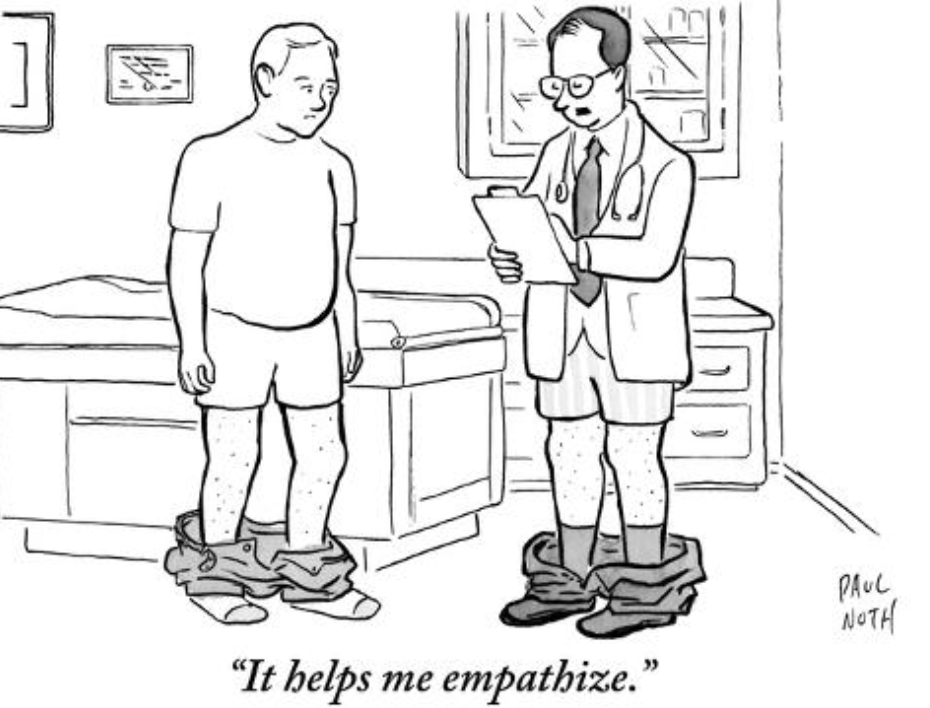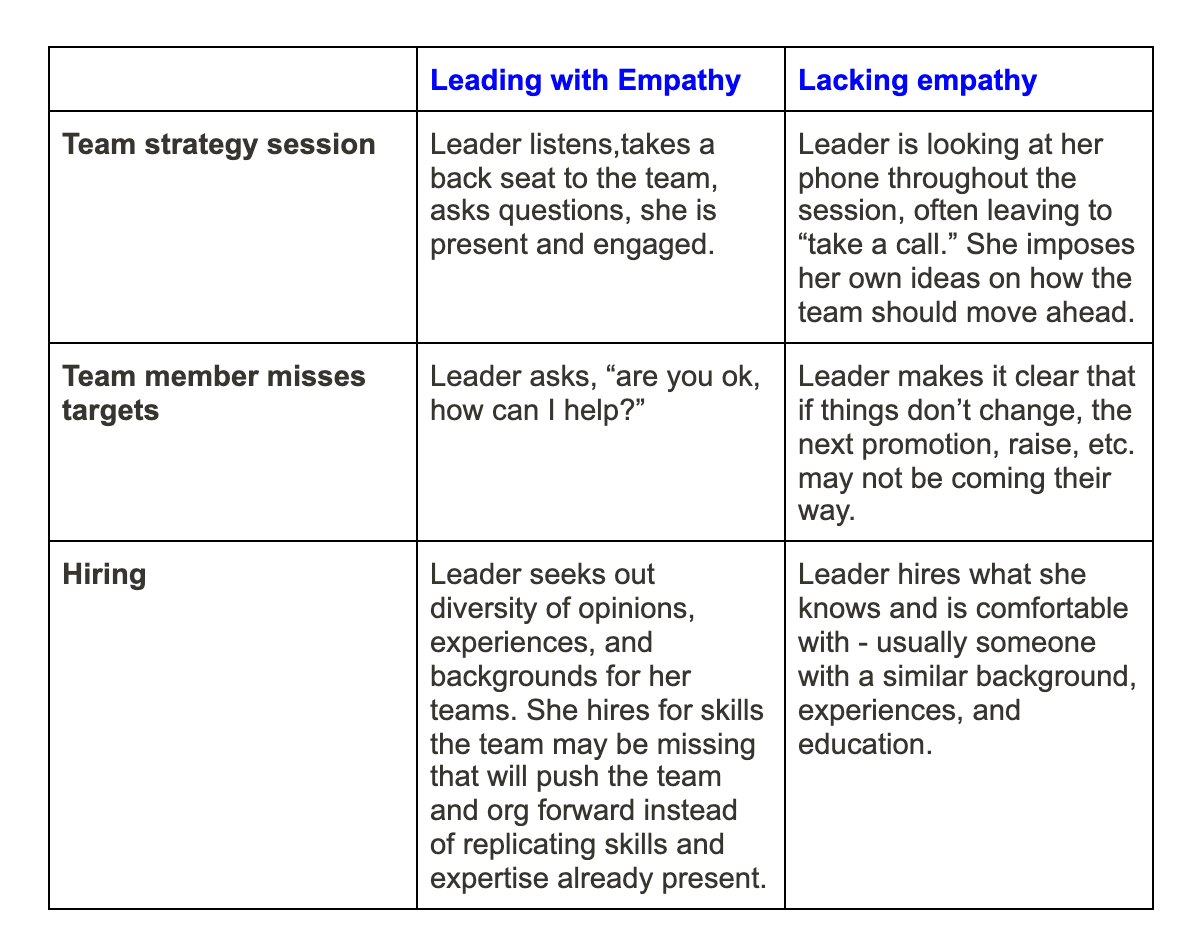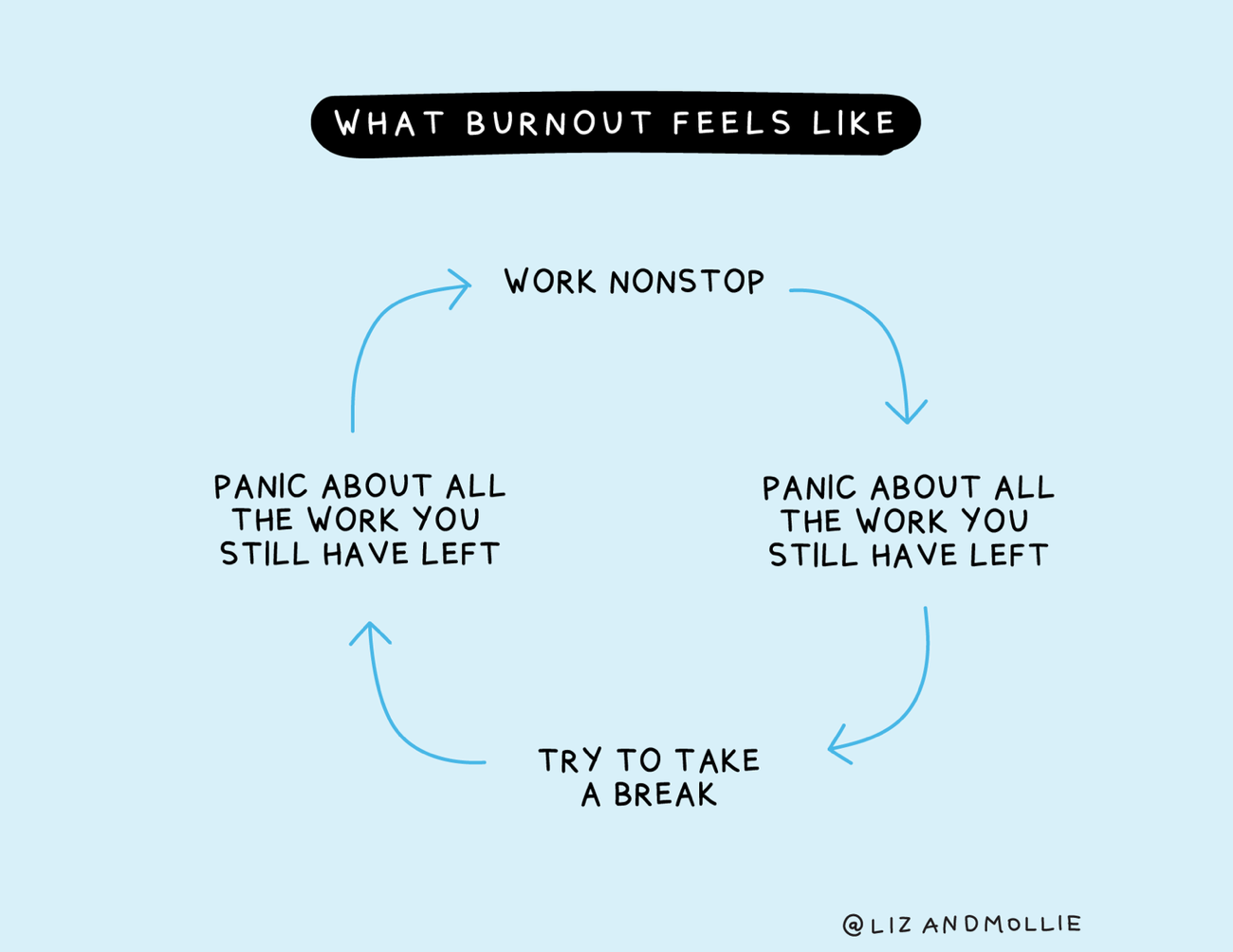Empathy is (an important) part of your job as a Product Leader
A few weeks ago, I ran a poll on LinkedIn and Twitter asking a simple question:
Which human skill do you think is most essential to building great products?
Self awareness
Empathy
Influence
Managing conflict
As you’re reading an article on empathy, you probably have a pretty good idea of what came out on top. (Yes, empathy was the clear winner in both polls). But why even ask the question in the first place?
I strongly believe that human skills like those listed above are meta skills that are just as essential to product management and leadership as more traditional skills like strategy development, data analytics, roadmap development, etc.
Research shows that individuals, teams and organisations that intentionally cultivate human skills like self awareness and empathy often outperform their competitors in value, innovation and productivity. There's growing evidence that human skills may be the competitive edge for high performing product teams and organisations. (That’s why I’ve written a book about the importance of hiring for skills like empathy in product management. These skills aren’t just “nice-to-haves” but essential “must-have” capabilities.)
Product management is more than a list of tasks and outputs. It’s a way of working, thinking, relating and leading. In many ways, it’s not just a role, but a culture in and of itself; the ability to be empathetic can make a huge difference in how leaders approach building that culture, and how their organisations respond to key questions around product creation and strategy.
The human skills I included in the survey above (and many that I didn't) are not just important, but may even be the deciding factor between whether a product or service is a long-lasting success that fills a real need, or a flash-in-the-pan that people only remember for the memes it left in its wake. Our products succeed or fail because of the people behind them, and that humanity is why skills like empathy cannot be ignored.
5 things that I bet you didn’t know about Empathy
I’m a bit of a research nerd. In order to better understand empathy, I scoured studies, research papers, articles, books - you name it. I always find far more information than I need. So, I'm just going to share a few nuggets that I've found especially interesting and relatable:
It’s really hard to define empathy. If you don’t quite understand what empathy is, you're not alone. Even the experts don’t really agree on a definition. According to an article in Scientific American, “Like many broad and complicated concepts, empathy can mean many things. Even the researchers who study it do not always say what they mean, or measure empathy in the same way in their studies.”
For example, experts disagree over whether empathy is actually feeling for others, feeling as others feel, or understanding others. Even so, most would agree to a version of this definition:
“Empathy is the ability to understand and share the thoughts or feelings of another.”
One other thing that many experts agree on is that there are actually three types of empathy: Cognitive, Emotional and Compassionate. (And yes, leaders need all three).
To be empathetic, you don’t need to actually have the same experiences as someone else; you are attempting to understand another person’s perspective by actually getting to know them, their circumstances, their thinking and emotions.
Origin Story. While it’s difficult to define empathy, its origin is much clearer:“Empathy” is inspired by the German aesthetic term Einfühlung, meaning "feeling into." The word first appeared, misspelled as enpathy in a 1909 lecture by the Cornell psychologist Edward B Titchener, and in a translation credited to the Cambridge philosopher and psychologist James Ward the same year.
Empathy is not the same as sympathy The terms empathy and sympathy are often confused. Both words deal with the relationship you have with the feelings and experiences of another person.
According to our friends at Dictionary.com, ”Sympathy is conveying commiseration, pity, or feelings of sorrow for someone else who is experiencing misfortune.” In the diagram below it’s described as feeling for someone, whereas Empathy is going a level deeper and feeling with someone’s pain.
Source: The Nielsen Norman Group
Empathy is contagious. Research shows that our levels of empathy are controlled by neurotransmitters — endorphins, dopamine, serotonin, and oxytocin — that reward us by making us feel good. So when we act empathetically, we get a natural kick that encourages us to show more empathy. Empathy begets empathy!
Yes, you can measure (and grow) empathy. Personally, I’ve never been a huge proponent of measuring human skills like self awareness or empathy. In my mind the more important thing is to realise you can grow your empathy, which you can, than quantifiably measuring your levels of empathy. If you’re one of those who are into personal growth data though, here you go.
These points barely scratch the surface on the fascinating aspects of empathy-especially the science behind it. For those interested, I’ll share a suggested reading list with links to more information at the end of the article.
(Lack of) Empathy in action
There will be times when your resolve to serve humanity will be tested. Be prepared. People will try to convince you that you should keep your empathy out of your career. Don’t accept his false premise.” -Tim Cook, Ceo, Apple
Let’s take a look at some common work scenarios where we see empathy being demonstrated, or where it’s clearly missing. Here’s a few that I’ve experienced:
These are just a very few examples of how a leader behaves with empathy and without. (I’m sure you all have mind-blowing examples too, that I’d love to hear about.)
Many of the leaders I’ve worked with admit they’re not always acting with empathy - yet still view themselves as empathetic. Many leaders also say that they feel they can’t show too much empathy towards their teams; because if they do they may risk losing credibility.
In a 2021 study of empathy in the workplace by Businesssolver, 68% of CEOs polled said that they fear they will be less respected if they show empathy in the workplace, up 31% over last year. I call this a leader’s empathy dilemma. If they show too much empathy, many fear that they won’t be taken seriously. If they don't show enough, they risk demotivating their teams and negatively impacting their entire organisation. And that is a big risk, because as I’ll talk about next, research shows that practicing empathy and building cultural norms based on empathy - be it in a product organisation or not - can have a massive positive impact on team member performance, levels of innovation and even the bottom line.
This “soft skill” can create real results for your organisation
Let’s look at what some of the numbers say about working and leading with empathy.
Empathy & employee engagement: A study from the 2017 Businessolver Workplace Empathy Monitor shows that empathy has a correlation with team member engagement and turnover:
60% of employees surveyed would be willing to take slightly less pay if their employer showed empathy.
77% of employees would be willing to work longer hours for an empathetic employer.
92% of employees who participated would be more likely to stay with a company that empathizes with their needs.
Yes, you read that correctly. According to the survey, empathy can be a massively motivating factor for team members, even over financial compensation.
Empathy & earnings: The Empathy Index takes a look at the culture of global companies - their cultures, CEO performance, ethics and social media presence of 170 companies on major financial indexes. Its latest report in 2016 showed that the top 10 companies from 2015 actually increased their value more than twice as much than the bottom 10, and increased earnings by 50%.
Empathy & High Performing Teams: In 2013, Google commissioned Project Oxygen to better understand what were the most essential skills that they should search for in hiring new candidates who would go on and be successful, high performing individuals and team members. Traditionally, Google’s hiring algorithm had been designed to look for candidates who attended elite universities and had a deep understanding of technology (much like its founders). However, after looking at the data, they found that candidates with human skills, including “empathy toward and being supportive of” colleagues, were best prepared for success at the organisation.
With all of this in mind, the idea that a human skill like empathy is just “nice to have” for product leaders needs to be set aside. So, how can you as a product leader start to make a difference?
Building your Empathy
“I think we all have empathy. We may not have enough courage to display it."
Maya Angelou
In order to build a culture of empathy, you have to have it yourself. So, let’s start by taking a look at how you, as a product leader or someone working towards a product leadership role, can start to build your own empathy.
Acknowledge that this is part of your job as a leader: In a talk on empathy, author and speaker Simon Sinek points out that ”Leaders get so concerned about their position in the organisation that they often forget their real job. The real job of a leader isn't about being in-charge. It's about taking care of those in our charge." Being a leader goes beyond coordinating processes and hitting numbers or taking care of customers. It’s helping those who are executing the process, hitting the number, and taking care of the customer. This is your job.
Adopt a growth mindset - Acknowledge that It is possible to develop human skills, like empathy. It’s not as easy or as fast as learning a new technical skill, but it is feasible. In her book “Mindset,” Carol Dweck talks about a growth mindset (believing you can change and grow) and a fixed mindset (believing there isn’t an opportunity to change). Research shows that people with a “fixed mindset” around empathy work less hard to connect with others. However, those with a growth mindset, believe it can be built and work towards real change.
Practice self-empathy: Having kindness for yourself; giving ourselves a break instead of criticizing ourselves. In my recent article on imposter phenomenon I talked about how self-criticism and limiting beliefs can have a massive impact on our lives. Practicing self-empathy can be another antidote to imposter phenomenon. When you feel yourself learning into self-criticism, take a moment and ask yourself “what would I say to a friend right now?” Most likely you’d be an empathetic support to your friend or colleague. Why not treat yourself the same way?
Model Behaviours - As a leader your behaviours and actions set a tone that your team and colleagues will pick up on. Is a member of your team missing their numbers? Instead of pushing them to hit the numbers or offering tactical quick fixes, ask if they’re ok. Go a level deeper and find out what’s going on. They’re on your team - and have been given this work for a reason.
Listen, I mean really listen - Active listening is a key skill to increase empathy, and yet it’s often misunderstood. What does it mean to “actively listen?” A few things. It means letting others talk, and listening to their stories. Keep track of how many times you interrupt someone in a 1:1 conversation. And gradually work to bring that number down. Try taking notes and asking questions to show you’re present and engaged.
Lead with questions - Taking care of people doesn’t mean solving their problems. It does mean being curious enough to try to seek out underlying needs and wants, and to help your team members find a path that actually works for them. Asking questions can break open a conversation and help your team member to find their own solution to a tricky situation.
You can work through these steps with a coach - be it an external coach or peer coaching with other leaders in your organisation - to help support and monitor your growth.
Empathetic Product Organisations
As your own empathy grows, take a look at how you can begin to build empathy in the organisation. Remember, empathy is contagious. As a leader, the more you act empathetically, the more it spreads across the organisation. Here are a few ways that you can help to create the foundations of a culture with empathy in your company.
Advocate for a comprehensive DEI approach -While many organisations are investing in diversity, equality and inclusion programs, there’s a gap in how leadership are viewing the success of these programs and how employees are. We need to look past the annual DEI workshops and buzzwords, and actually identify where our org blindspots in DEI are living, and act.
Build a recognition habit. As the survey results above about employee engagement show, people want to know they did a great job, however, to make this authentic, look beyond the “employee of the month” newsletter mention and make recognition a daily habit. Why not try out a moment of recognition in your daily stand-ups or weekly team meetings.
Develop a mentoring program -Create opportunities for your team to work with other empathetic leaders across the organisation through mentoring. The more our team members experience empathy in action, the great chance we have at making it a foundational element of our ways of working.
Think again about how you motivate your team members - In Drive: The Surprising Truth about what Motivates Us, Daniel Pink talks about why it’s not always money that motivates a person. An empathetic leader asks questions and builds relationships with her team members to get to a deeper level understanding of what authentically motivates someone. An empathetic organisation offers flexibility in its system to respond and offer incentives that match those individual motivational needs.
This is really just the beginning of the conversation about empathy and how it can help you become a better product leader and more empathetic organisation.
Soon, I’ll be sharing information about a 90 min Master Class on Empathy for Product Leaders. If you’re interested in growing your own empathy or building a product culture based on empathy, sign up for more information.
In the meantime, here’s some additional reading to keep you going:
Subscribe to Product Leadership Essentials
Sign-up to my email newsletter to learn more about how to better understand and build your authentic Product Leadership skills.





